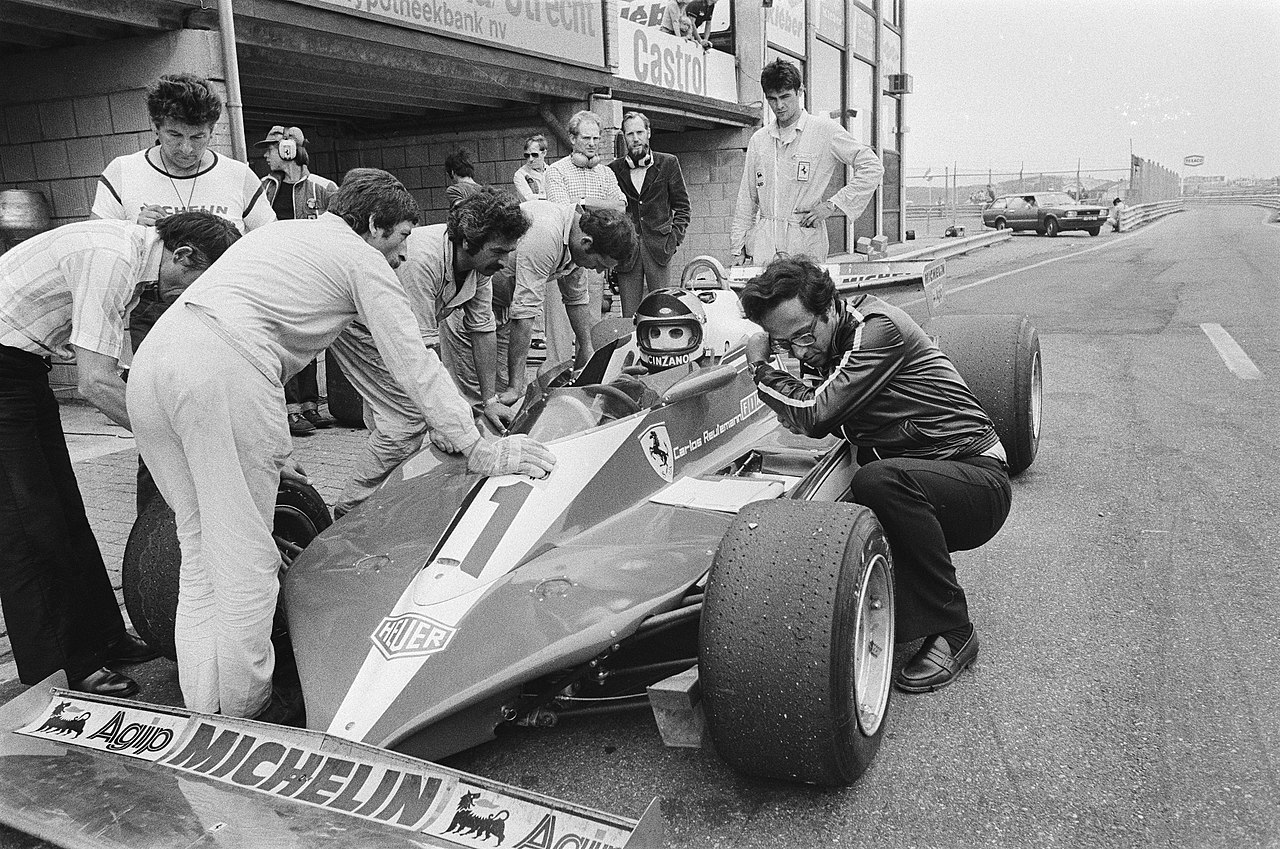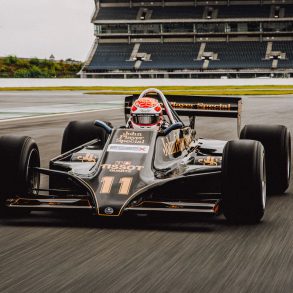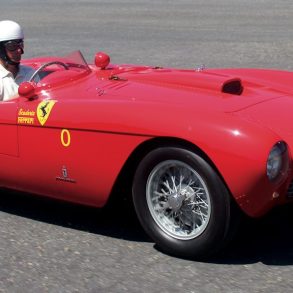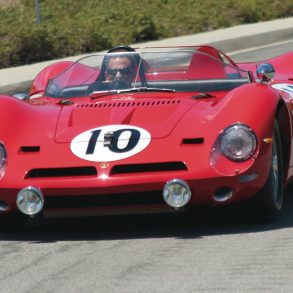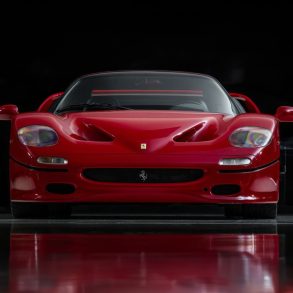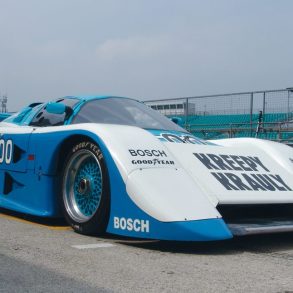Mauro Forghieri Biography
In 1961, following an internal upraising, the infamous Laura Affair, Enzo Ferrari fired the entire management team of his company, including top engineers Carlo Chiti and Giotto Bizzarrini who promptly set up what they hoped to be a rival teo Ferrari, Automobili Turismo e Sport (ATS). They build not only a formula car but also a car for the road helped with financing by Scuderia Serenissima’s Count Giovanni Volpi. Mauro Forghieri was then a 27-year-old trainee engineer at Maranello, fresh from his studies at Bologna University. Almost overnight, he found himself appointed the new technical director. “I was scared,” Forghieri remembers. “And I told Ferrari so, but he reassured me by saying he was behind me. He taught me that you never have to feel defeated before-hand.” The relationship with the Commendatore had its ups and downs, but the string never broke:
“We were both from Emilia, same passionate personality and warm blood. Of course, sometimes he shouted at me and vice-versa, but there was a great deal of respect between us. It is fair to say that he ‘created’ me and never destroyed me, contrarily to others…”
1961 was a year marked with triumph and tragedy for Ferrari and it’s founder. During the 1957 Mille Miglia, near the town of Guidizzolo, a 4.0-litre Ferrari 335S driven by Alfonso de Portago was traveling at 250 km/h when it blew a tyre and crashed into the roadside crowd, killing de Portago, his co-driver and nine spectators, five of whom were children. In response, Enzo Ferrari and Englebert, the tyre manufacturer, were charged with manslaughter in a lengthy criminal prosecution that was finally dismissed in 1961. Ferrari was leading in the World Championship eventually won by Phil Hill but tragedy struck again when on the 10th of September Wolfgang von Tripps was killed along with 10 spectators at Monza. Some now claimed that the legend of Ferrari was built upon dead people. The walkout/purge could not have happened at a worse time for Ferrari.

Forghieri would remember the lessons he learned from long time Ferrari associate Luigi Bazzi and the famous Vittorio Jano, men who’s practical experience were unmatched. Chiti on the other hand took no advise from his junior engineer. While Forghieri was tasked to the engine department, Dallara worked in the chassis section.
When the purge came the racing department had 170 people working there including Ferrari, his secretary, and his drivers, their time was split between F1, hillclimbs, and prototype racing for Le Mans, the Targa Florio, and the Nurburgring endurance races. Forghieri would lead the department as part of a troika with engine man Franco Rocchi and fellow engineer Giancarlo Bussi. The racing world wouldn’t stop while Forghieri learned his job which at the end he would considered one of Ferrari’s greatest engineers, the last of a breed that could design an entire car, rather than just a section or component, though it was the design of engines that he enjoyed most.

Ferrari’s Formula 1 fortunes would continue to take and up and down nature. In 1965 John Surtees was injured at a Can Am race in September and would be out for the rest of the year. Surtees came back to win the 1966 Belgian Grand Prix at Spa but reliability issues doomed his chance at any championship.
But all was not well with Surtees at Ferrari. Ever since 1963 Surtees had been at odds with team manager Eugenio Dragoni. Ferrari for their part was suspicious of Surtees’ relationship with Lola’s Eric Broadley whose Lola T70 competed with Ferrari’s sports cars. At Le Mans in 1966 Surtees was omitted from the line-up and when Surtees questioned Ferrari team manager as to why, Dragoni told Surtees that he did not feel that he was fully fit to drive in a 24-hour endurance race. This may have been the proverbial straw that broke the camel’s back and his estrangement from the team became permanent. Eventually, Surtees agreed along with Enzo Ferrari that their split was a disastrous mistake for both parties. “I could probably have won another two or three world championships if I had stayed with Ferrari,” Surtees later admitted.
Sports Car Racing

In sports car endurance racing Ferrari continued to see success on the track. The legendary Ferrari 250 GTO was produced from 1962 to 1964 for homologation into the FIA’s Group 3 Grand Touring Car category. The 250 GTO, stared under the auspices of Giotto Bizzarrini, with further development overseen by new engineer Mauro Forghieri and Carrozzeria Scaglietti, an Italian automobile design and coachbuilding company who built the body from a Pininfarina design. The mechanical aspects of 250 GTO were relatively conservative at the time of its introduction, using engine and chassis components that were proven in earlier competition cars. The chassis of the car was based on that of the 250 GT SWB, with minor differences in frame structure and geometry to reduce weight, stiffen and lower the chassis. Early development of the new model was shrouded in secrecy, with Giotto Bizzarrini charged with developing a car to take on and beat the Jaguar E Type. The 250 GTO would be the last front-engined car to win the Le Mans 24hr race. Ferrari would make a belated but successful switch to mid-engined cars in attempt to withstand the onslaught of the Ford Company and it GT40s. The 330 and 512 series would be their answer.
Ferrari at the Targa Florio
Ferrari has been racing at the Targa Floria race since 1920, first as a driver for Alfa Romeo then as a constructor winning the first post-war edition of the race in 1948 with Clemente Biondetti driving a Ferrari 166S, the first of 7 victories in the Sicilian classic. In 1965 Ferrari won with their Forghieri resigned mid-engined 275P driven by Lorenzo Bandini and local hero Nino Vaccarella who would later remark that:
“when it came to the Targa, others would come to practice a day or two before the race, but I went all the time. With the Targa, there was endless gear shifting, and I drove most of it one-handed. At the end of the race I would have blisters on my hand.”
His 1965 win was all the more heroic because Porsche had a strong team, taking the next four places behind him. It was a sign of things to come, Porsche would win the next five Targas in a row. Not till 1972 would another Ferrari win the Targa Florio.
In 1971, Ferrari focused on a new 3.0L prototype based on the 180° flat-12 boxer from the 312B F1 car. Officially this design was known as 312P, the motorsports press appending the B to avoid confusion with the earlier 312P V12 cars. In 1972 a Ferrari 312PB would win with Arturo Merzario and Sandro Munari driving. The Ferrari 312PB was Ferrari’s last sports prototype before they exited sports car racing to focus their efforts solely on Formula One.
Aerodynamics
New regulations called for the Le Mans racers to more closely resemble road cars including the use of a full-width windscreen. In 1961 this was answered by high rear decks with spoilers but this had minimal effect on high speed stability. For the following season Forghieri and Enmondo Casoli came up with a roll bar that wasn’t really a roll bar but an inverted airfoil which was built into the 330 TRI/LM, behind the cockpit and at the same level as the top of the windscreen. The modification had several purposes, one was to reduce the turbulence in the wake of the windscreen and another to produce downforce. The new car was driven with great effect by Phil Hill and Oliver Gendebien to victory at Le Mans in June. This device would continue to be used in open sports cars raced by Ferrari.
Michael May, an engineer who consulted for Ferrari in 1963-64 on its adoption of Bosch direct fuel infection for its racing engines, had pioneered the use of an enormous mid-mounted wing on his privately entered Porsche 550 Spyder, at the 1956 Nurburgring 1000 km race. His car was so fast in practice that the Porsche factory team manager supported those who argued successfully for the removal of its wing. May mentioned the function and success of the wing to Ferrari engineer Mauro Forghieri. It was Forghieri, who combined talking to May about the wing he had used previously and using the information given him about the Lotus wing experimented with in New Zealand, then engineered, built and mounted an aerodynamically sound wing on the 312 F1 Ferrari and tested it in 1968. Later Forghieri added twin hydraulic cylinders that allowed the driver to control the angle of the wing.
Aerodynamics were really starting to play a big role in car design in those days, and we hired a great aerodynamicist. When wanting to gain gain some of the same aerodynamic insight that the British teams gained thanks to the aircraft windtunnels available to them, Forghieri asked Enzo Ferrari for permission to hire the full-scale tunnel in Stuttgart that was known for its automobile research. “On that occasion he was decidedly long-sighted,” recalled Forghieri.
“Due to their cost, windtunnels were not used much in Italy at the time. Ferrari understood that it could be an advantage. This was a big concession by the man who long held that horsepower alone was the key to racing success”, mused Forghieri.
When we sent the car to the windtunnel, Forghieri recalled telling the aerodynamicist, “I designed this car, the chassis, the gearbox, the engine and bodywork, but when we send it to the tunnel let the wind dictate its final form—we will accept whatever shape the windtunnel gives the car”. Of course, Ferrari told us “It’s ugly!” but we countered “Yes, but it’s very good!”
To provide for the future, during the summer of 1968, Ferrari worked out a deal to sell his road car business to Fiat for $11 million; the transaction took place in early 1969, leaving 50% of the business still under control of Ferrari himself. During 1969 Enzo Ferrari set about wisely spending his new-found wealth to revive his struggling team; though Ferrari did compete in Formula One in 1969, it was something of a throwaway season while the team was restructured.

The Ferrari 312B which was introduced for the 1970 Formula One season. Forghieri had two goals in mind in Modena, to design a new motor from a clean sheet of paper similar to what Keith Duckworth of Cosworth had done and to investigate the lowering of a race car’s Polar Moment of Inertia, also called center mass. For a car it basically means, the mass is concentrated near the CoG. That´s the case with all/most mid-engined sports/race cars. This leads to an very nimble handling, easy to change direction, however it also results in more rapid ‘break away’ and loss of control at a higher cornering speed … that’s where the driver comes in.

Doug Nye; “The 312B…was quite the best integrated 3 litre F1 package yet created. It would remain the best packaged of all Ferrari’s until the Postlethwaite 156 appeared in 1985” he said writing in 1986. “I always thought the 312T/T2 were pretty handy bits of integrated kit, but the point is, the car was a beautifully designed and executed car!”
At back-to-back tests in Stuttgart University’s wind tunnel, it was discovered that the two-seater (312PB), with its enveloping body, generated much more downforce than its slender monoposto cousin. Even with its wheels still exposed, surmised Forghieri, an F1 car with a wide, flat top surface would generate greater aero grip than did the current ‘Coke bottle’ cars of Tyrrell and McLaren etc. This would, in turn, mean that a larger percentage of the car’s weight could be sited within its wheelbase instead of hanging a chunk of it over the rear in a quest for better traction. It would also mean that less rear wing would be required, ergo more straight-line speed.

Ferrari Flat-12 Engine
The clean sheet of paper that met Mauro Forghieri was soon filled with twelve cylinders set at 180 degrees. Forghieri wanted to reduce the rotating inertia of the crankshaft and minimize the engine’s friction and pumping losses. Wasting less horsepower inside the engine would ensure more reached the rear wheels.
This would be accomplished by using only four main bearings. The crankshaft was machined from a special alloy billet imported from the USA and it had four chain-driven overhead camshafts running on needle rollers.
To cure early crankshaft failures, Forghieri had a specially developed coupling between the crankshaft and flywheel, the purpose being to transfer flexing stresses along the length of the crankshaft. The engine was capable of sustained operation at 13,500 rpm had the available ignition and injection systems been available. Starting in 1970 the 312 Flat-12 engine would enjoy an 11-year run in both sports and Formula 1 cars. Keith Duckworth (Cosworth), according to contemporaries, never seemed particularly impressed by Italy’s racing engines, unless they wore ‘Ferrari’ lettering.
Ferrari 312 Series
The Formula One 312 series, 3 for three litre and 12 for twelve cylinders were a series of very different cars. In 1967, the team fired Eugenio Dragoni and replaced him with respected journalist Franco Lini. Chris Amon partnered Lorenzo Bandini to drive a somewhat improved version of the 1966 V12 car.
At the 1967 Monaco Grand Prix, Bandini crashed, the car burst into flames and the unfortunate Bandini succumbed to his injuries. Ferrari re-hired Mike Parkes, but Parkes suffered career-ending injuries weeks later at the 1967 Belgian Grand Prix. The new Ford Cosworth DFV engine that had its debut in the Lotus 49 would come to dominate F1 during the era of the garagistas.
I was impressed by Mauro Forghieri when I first met him in 1969, and liked him immediately. He was the sort of person you could joke with, and when I saw the flat-12 at the Canadian Grand Prix in 1970 1 said “what a wonderful engine- thank goodness you’ve only got an old nail of a chassis to put it in!”. We were standing by my car at the time, the Tyrrell 001, which had yet to do very much at all, but it was on pole position at that Grand Prix. Luckily he laughed, but what I didn’t know was that he had a better car on the drawing board, so he could afford to laugh. Derek Gardner as told to Motorsport Magazine
The Ts

Forghieri promptly exhumed his center-mass concept which would lead to his brilliant transverse gearbox. The new five speed transmission cluster was positioned across the car ahead of the rear axle line with the shafts lying at right-angles to the centre-line of the car and the drive taken via bevel gears on the input side of the gearbox.
“When Mauro Forghieri first showed me the drawings of the 312T,” recalls Lauda, “I felt indifferent about the whole project. I didn’t really appreciate the advantages that it would offer because it seemed to be such a very big change away from a chassis about which we knew everything.” In practice it worked brilliantly in conjunction with the low CoG of the flat-12 to make a car that sat on pole 10 times in 1974 thanks to Niki Lauda (nine) and Clay Regazzoni (1) and a World Championship car a year later. “But then, when I got to drive it around Fiorano, Ferrari’s test track, I quickly appreciated that it was a much more competitive proposition. It was clear that it was in a different class. The strength of the new design was its totally neutral handling, and a wide torque curve from the superbly flexible flat 12 engine. Driveability”, Lauda says, was the key.
“Forghieri was a genius but you needed to control him,” Lauda adds. “I remember at Barcelona in practice, I came in and told him I had understeer. He said, ‘You’re taking the wrong lines’. I asked where, and he said, ‘Round the back of the circuit’ ‘How do you know?’ Because I have a friend out there who tells me.’ ‘Who’s your friend?’ Ah, it’s the lady friend of my doctor.’ I said, ‘Fix my f***ing understeer.’ He did and I put it on pole.” Niki Lauda as told to Motorsport Magazine
Even though it was Forghieri that utilized the first workable rear wing in Formula 1 he must have realized that the British would have the advantage when it ultimately came to aerodynamics so to even Ferrari’s chances they needed to emphasis the mechanical advantage of any new design. The British dominance would come in the form of ground effects.
Form follows Function
Of all the cars that Forghieri designed, his favorite was actually a sports car, the 330 P4, which took a stunning win at the Daytona 24 Hours in 1967 and is arguably one of the most beautiful racing cars ever built.

Only four Ferrari P4-engined cars were ever made: three new 330 P4s and one ex P3 chassis (0846).Their three-valve cylinder head was modeled after those of Italian Grand Prix-winning Formula One cars.
“The P4 was a very pleasant car to drive, as it was a great deal more nimble than the Fords I was used to. Although it lacked the ultimate top end pace of the 7-litre Ford, it gave you the feeling that you could drive it to the maximum for the whole race, which really wasn’t the case for the Fords, especially the brakes … “, recalled Chris Amon who had a chance to drive both cars.
As a counter-example, he cites the 312T4 that took the title in 1979 with Jody Scheckter: In Formula One everybody was talking about “ground effect” and single-seaters were planned to generate under-body downforce for higher corner speed. With help from Fiat and Pininfarina Ferrari hastily adapted the successful 312T chassis for ground effects use, even though the The 180° V12 engine and the transversal gearbox didn’t allow the Ferrari to benefit from the ground effect very well due to the space conditions in the rear of the car, which weren’t favorable in terms of air (Venturi) outlet.

Forghieri remained with Ferrari until 1987, then joined Lamborghini’s fledgling competition department. Leaving Ferrari, was not an easy decision for Forghieri but the result of a number of issue regarding the state of his employment. With Ferrari’s health declining, he was without his greatest benefactor, Fiat’s men were all over the racing department and Piero, Ferrari’s son was progressively “stretching his wings” and it was past time for Forghieri to leave.
Lamborghini, the rival Italian super car manufacturer was now owned by Chrysler. He would concentrate on advanced special projects which included the development of a naturally aspirated 3.5-litre Grand Prix engine. Chrysler at the time was interested building up a Formula One involvement. The effort never really accomplished a lot and Forghieri only stayed for several years before forming his own firm, Oral Engineering. Today besides his work at Oral Engineering he writes technical articles for specialist journals, and is often invited to talk and lecture on his experiences.












